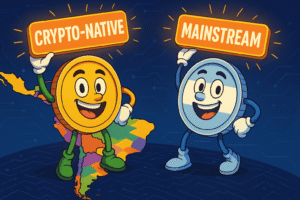How Stablecoins Can Facilitate DeFi Applications

How Stablecoins Can Facilitate DeFi Applications
Decentralized Finance (DeFi) is the new buzzword in the financial world. It is a system that offers a decentralized and transparent financial ecosystem, which is open to anyone with an internet connection. However, the lack of stability in cryptocurrencies has always been a major concern for Decentralized Finance applications. Stablecoins, a new form of cryptocurrency, can potentially solve this problem and facilitate the growth of DeFi applications. In this article, we will discuss how stablecoins can facilitate DeFi applications.
Introduction to Stablecoins
Stablecoins are a new form of cryptocurrency that aims to solve the volatility problem of traditional cryptocurrencies. They are designed to maintain a stable value by pegging their value to a stable asset, such as a fiat currency, a commodity, or a cryptocurrency. This stability makes them ideal for use in Decentralized Finance applications.
Stability in DeFi Applications
DeFi applications are decentralized and open-source, which means that anyone can participate in them. This openness has led to the creation of a vibrant ecosystem of decentralized exchanges, lending platforms, and other financial applications. However, the lack of stability in cryptocurrencies has always been a major concern for Decentralized Finance applications.
The volatility of cryptocurrencies makes them unsuitable for use in traditional financial applications. For example, a loan denominated in Bitcoin may be worth a lot more or a lot less than its original value by the time it is repaid. This uncertainty makes it difficult for lenders to assess the risk of the loan, and for borrowers to plan their repayments. Stablecoins can potentially solve this problem by providing a stable value that can be used in Decentralized Finance applications.
Advantages of Stablecoins in DeFi Applications
Stablecoins offer several advantages over traditional cryptocurrencies in DeFi applications. Some of these advantages are:
Stability
As mentioned earlier, the stability of stablecoins makes them ideal for use in Decentralized Finance applications. They provide a stable value that can be used for lending, borrowing, trading, and other financial applications.
Speed
Stablecoins can be transferred quickly and easily across the blockchain. This speed makes them ideal for use in decentralized exchanges, where transactions need to be executed quickly.
Security
Stablecoins are designed to be secure and transparent. They use the same encryption techniques as traditional cryptocurrencies, which makes them resistant to hacking and other forms of cyberattacks.
Accessibility
Stablecoins can be used by anyone with an internet connection. This accessibility makes them ideal for use in DeFi applications, which are designed to be open to everyone.
Use Cases of Stablecoins in DeFi Applications
Stablecoins can be used in various DeFi applications. Some of the use cases of stablecoins in Decentralized Finance applications are:
Lending and Borrowing
Stablecoins can be used for lending and borrowing. Lenders can earn interest by lending stablecoins to borrowers, who can use the stablecoins to finance their projects or repay their debts.
Trading
Stablecoins can be used for trading cryptocurrencies on decentralized exchanges. Traders can use stablecoins to buy or sell cryptocurrencies without worrying about the volatility of traditional cryptocurrencies.
Payments
Stablecoins can be used for making payments in Decentralized Finance applications. They can be used to pay for goods and services or to transfer money across borders.
Challenges of Stablecoins in DeFi Applications
Stablecoins are still a relatively new technology, and there are some challenges that need to be addressed. Some of these challenges are:
Centralization
Some stablecoins are centralized, which means that they are controlled by a central authority. This centralization goes against the decentralized nature of Decentralized Finance applications.
Regulatory Issues
Stablecoins may face regulatory issues in some jurisdictions. Some regulators may consider stablecoins as securities, which means that they may be subject to securities laws and regulations.
Market Adoption
Stablecoins are still a relatively new technology, and their adoption in the market may take time. It may take some time for people to trust stablecoins and for them to become widely accepted in the market.
Conclusion
Stablecoins have the potential to facilitate the growth of DeFi applications by providing stability and security. They offer several advantages over traditional cryptocurrencies, such as stability, speed, security, and accessibility. Stablecoins can be used in various DeFi applications, such as lending, borrowing, trading, and payments. However, there are also some challenges that need to be addressed, such as centralization, trust, regulatory issues, and market adoption. Overall, stablecoins are a promising technology that can potentially revolutionize the financial world.
FAQs
Q: What are stablecoins?
A: Stablecoins are a type of cryptocurrency that are designed to maintain a stable value, usually pegged to a fiat currency like the US dollar. This stability makes them a useful tool for transactions and investments.
Q: What are DeFi applications?
A: DeFi, or decentralized finance, applications are financial applications built on blockchain technology that operates without the need for traditional financial intermediaries like banks. These applications allow users to access financial services like lending, borrowing, and trading without relying on centralized institutions.
Q: How can stablecoins facilitate DeFi applications?
A: Stablecoins can facilitate DeFi applications by providing a stable value that allows for reliable transactions and investments. Stablecoins can be used to provide liquidity to DeFi platforms, as well as to collateralize loans and other financial products.
Q: What are the benefits of using stablecoins in DeFi applications?
A: Stablecoins offer several benefits in DeFi applications, including stability of value, fast and low-cost transactions, and easy integration with existing financial systems. Stablecoins can also help to mitigate the volatility that is often associated with traditional cryptocurrencies.
Q: What are some examples of stablecoins used in DeFi applications?
A: There are several stablecoins used in DeFi applications, including USDT, USDC, DAI, and TUSD. These stablecoins are often used to provide liquidity to decentralized exchanges, collateralize loans, and facilitate other financial transactions.
Q: How are stablecoins different from other cryptocurrencies?
A: Stablecoins are different from other cryptocurrencies in that they are designed to maintain a stable value, usually by being pegged to a fiat currency or commodity. This stability makes them useful for transactions and investments, whereas other cryptocurrencies like Bitcoin are often used for speculative trading and investment.
Q: Are stablecoins regulated by governments or financial institutions?
A: It depends on the stablecoin. Some stablecoins, like USDT and USDC, are issued by centralized institutions and may be subject to government regulations. Other stablecoins, like DAI, are decentralized and operate without a central authority. However, as stablecoins become more widely used, it is possible that they may face increased regulation from governments and financial institutions.

I have been in the industry for over 5 years. I know all the latest news and what is going on with different coins. I write about Bitcoin, Ethereum, Litecoin, and more.








